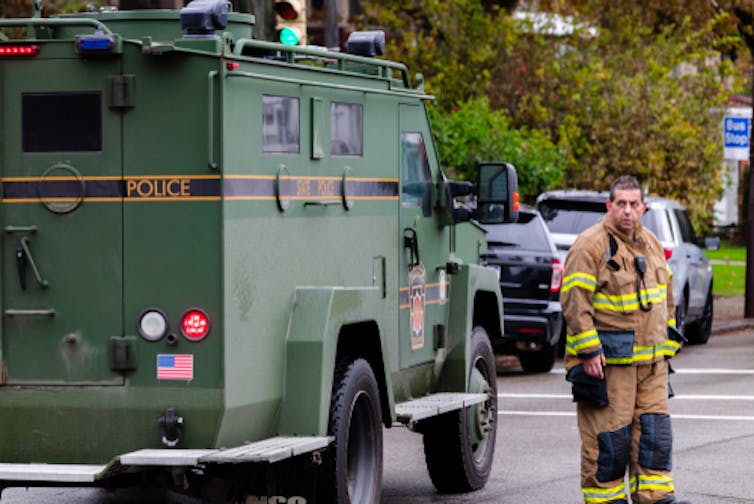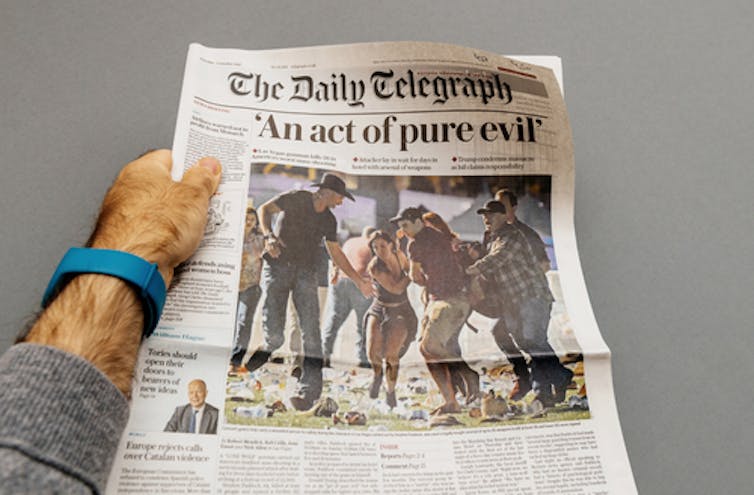Mass shootings leave emotional and mental scars on survivors, first responders and millions of others
- Written by Arash Javanbakht, Associate Professor of Psychiatry, Wayne State University
The deadly shootings of eight people in Atlanta[1] on March 16 and 10 people in Boulder, Colorado[2], on March 22 brought heartache and grief to the families and friends of the victims.
These events also take a toll on others, including those who witnessed the shooting, first responders, people who were nearby – and even those who heard about the shooting in the media.
I am a trauma and anxiety researcher and clinician[3], and I know that the effects of such violence reach millions. While the immediate survivors are most affected, the rest of society suffers, too.
First, the immediate survivors
Like other animals, we humans get stressed or terrified when exposed to a dangerous event. The extent of that stress or fear can vary. Survivors of a shooting may want to avoid the neighborhood where the shooting occurred or the context related to shooting, such as grocery stores, if the shooting happened at one. In the worst case, a survivor may develop post-traumatic stress disorder, or PTSD.
PTSD is a debilitating condition that develops after exposure to serious traumatic experiences such as war, natural disasters, rape, assault, robbery, car accidents – and, of course, gun violence. Nearly 8% of the U.S. population deals with PTSD[4]. Symptoms include high anxiety, avoidance of reminders of the trauma, emotional numbness, hypervigilance, frequent intrusive memories of trauma, nightmares and flashbacks[5]. The brain switches to fight-or-flight mode, or survival mode, and the person is always waiting for something terrible to happen.
When the trauma is caused by people, as in a mass shooting, the impact can be profound. The rate of PTSD in mass shootings may be as high as 36% among survivors[6]. Depression, another debilitating psychiatric condition, occurs in as many as 80% of people with PTSD[7].
Survivors of shootings may also experience survivor’s guilt[8], the feeling that they failed others who died or did not do enough to help them, or just guilt at having survived.
PTSD can improve by itself, but many people need treatment. We have effective treatments available in the form of psychotherapy and medications. The more chronic it gets, the more negative the impact on the brain, and the harder to treat.
Children and adolescents, who are developing their worldview and deciding how safe it is to live in this society, may suffer even more. Exposure to such horrific experiences or related news can fundamentally affect the way they perceive the world as a safe or unsafe place, and how much they can rely on the adults and society in general to protect them. They can carry such a worldview for the rest of their lives, and even transfer it to their children.
The effect on those close by, or arriving later
PTSD can develop not only through personal exposure to trauma, but also via exposure to others’ severe trauma. Humans are evolved to be sensitive to social cues and have survived as a species particularly because of the ability to fear as a group. That means humans can learn fear and experience terror through exposure[9] to the trauma and fear of others. Even seeing a frightened face in black and white on a computer will make our amygdala[10], the fear area of our brain, light up in imaging studies.
People in the vicinity of a mass shooting may see exposed, disfigured, burned or dead bodies. They may also see injured people in agony, hear extremely loud noises and experience chaos and terror in the post-shooting environment. They must also face the unknown, or a sense of lack of control over the situation. The fear of the unknown plays an important role in making people feel insecure, terrified and traumatized.
I, sadly, see this form of trauma often in asylum seekers exposed to torture of their loved ones, refugees exposed to casualties of war, combat veterans who lost their comrades and people who have lost a loved one in car accidents, natural disasters or shootings.
 A first responder after the shooting Oct. 27, 2018, at Tree of Life synagogue in Pittsburgh.
B Peterson[11]
A first responder after the shooting Oct. 27, 2018, at Tree of Life synagogue in Pittsburgh.
B Peterson[11]
Another group whose trauma is usually overlooked is the first responders[12]. While victims and potential victims try to run away from an active shooter, the police, firefighters and paramedics rush into the danger zone. They frequently face uncertainty; threats to themselves, their colleagues and others; and terrible bloody post-shooting scenes. This exposure happens to them too frequently. PTSD has been reported in up to 20% of first responders[13] to mass violence.
Widespread panic and pain
People who were not directly exposed to a disaster but who were exposed to the news[14] also experience distress, anxiety or even PTSD. This happened after 9/11[15]. Fear, the coming unknown – is there another strike? are other co-conspirators involved? – and reduced faith in perceived safety may all play a role in this.
Every time there is a mass shooting in a new place, people learn that kind of place is now on the not-very-safe list. People worry not only about themselves but also about the safety of their children and other loved ones.
Media: Good, bad and sometimes ugly
 The Daily Telegraph front page of the shootings in Las Vegas on Oct. 1, 2017.
Hadrian/Shutterstock.com[16]
The Daily Telegraph front page of the shootings in Las Vegas on Oct. 1, 2017.
Hadrian/Shutterstock.com[16]
I always say American cable news purveyors are “disaster pornographers.” When there is a mass shooting or a terrorist attack, they make sure to add enough dramatic tone to it to get all the attention.
Besides informing the public and logically analyzing the events, one job of the media is to attract viewers and readers, and viewers are better glued to the TV when their positive or negative emotions are stirred, with fear being one. Thus, the media, along with politicians, may also play a role in stirring fear, anger or paranoia about one or another group of people.
When we are scared, we are vulnerable to regress to more tribal and stereotyping attitudes. We can get trapped in fear of perceiving all members of another tribe as a threat if a member of that group acted violently. In general, people may become less open and more cautious around others when they perceive a high risk of exposure to danger.
Is there any good to come of such tragedy?
As we are used to happy endings, I will try to also address potentially positive outcomes: We may consider making our gun laws safer and opening constructive discussions, including informing the public about the risks, and encouraging our lawmakers to take meaningful action. As a group species, we are able to consolidate group dynamics and integrity when pressured and stressed, so we may raise a more positive sense of community. One beautiful outcome of the tragic shooting at the Tree of Life synagogue in October 2018 was the solidarity of the Muslim community with the Jewish[17]. This is especially productive in the current political environment, with fear and division being so common.
The bottom line is that we get angry, we get scared and we get confused. When united, we can do much better. And, do not spend too much time watching cable TV; turn it off when it stresses you too much.
Editor’s Note: This is an updated version of an article originally published on Nov. 9, 2018. https://theconversation.com/what-mass-shootings-do-to-those-not-shot-social-consequences-of-mass-gun-violence-106677
References
- ^ The deadly shootings of eight people in Atlanta (www.cnn.com)
- ^ 10 people in Boulder, Colorado (www.cnn.com)
- ^ trauma and anxiety researcher and clinician (scholar.google.com)
- ^ U.S. population deals with PTSD (www.ptsd.va.gov)
- ^ high anxiety, avoidance of reminders of the trauma, emotional numbness, hypervigilance, frequent intrusive memories of trauma, nightmares and flashbacks (www.ptsd.va.gov)
- ^ 36% among survivors (doi.org)
- ^ 80% of people with PTSD (theconversation.com)
- ^ survivor’s guilt (www.ptsd.va.gov)
- ^ learn fear and experience terror through exposure (theconversation.com)
- ^ amygdala (doi.org)
- ^ B Peterson (www.shutterstock.com)
- ^ first responders (theconversation.com)
- ^ 20% of first responders (doi.org)
- ^ exposed to the news (doi.org)
- ^ 9/11 (doi.org)
- ^ Hadrian/Shutterstock.com (www.shutterstock.com)
- ^ Muslim community with the Jewish (www.washingtonpost.com)
Authors: Arash Javanbakht, Associate Professor of Psychiatry, Wayne State University

